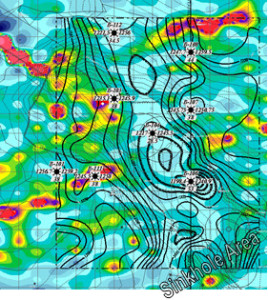Challenge
Construction on top of the solution-prone Burlington-Keokuk Limestone bedrock found in southwestern Missouri always has the potential for karst-related problems. Prior to contacting Mundell, a geotechnical engineer had advanced over sixty (60) soil borings across a proposed retail site located near Republic, Missouri, in an attempt to characterize the subsurface geology. The borings indicated an irregular bedrock surface. These results, along with the known existence of sinkholes across the site, led to the suggestion that a geophysical investigation be conducted to map out any unknown karst features present beneath the site.
Action
To characterize the bedrock beneath the site and locate any unknown karst features, Mundell selected deep conductivity mapping using a Geonics EM-34 Terrain Conductivity Meter with a 10-meter coil spacing in both the horizontal and vertical dipole modes. This technique provided a map view of the geology beneath the site at both the 7.5 meter and 15 meter depths. Potential karst features detected using this technique were then further characterized using an AGI Sting R1 Resistivity Meter to collect a total of four, vertical, 2 dimentional resistivity profiles designed to provide a cross-sectional view of the karst geology present beneath the site.
Results
In order for better data correlation, the conductivity data were converted into resistivity data (conductivity is the inverse of resistivity). The horizontal dipole map shows the near surface materials (residual soils, fill, and weathered bedrock) as well as the shallowest bedrock, and correlated well with the geotechnical borings. The vertical dipole map emphasizes deeper features within the bedrock, showing where the bedrock is competent, and where it is not. The 2-D resistivity profiles supported the conductivity results, allowing for the karstic features detected beneath the site to be accounted for in the construction design.





